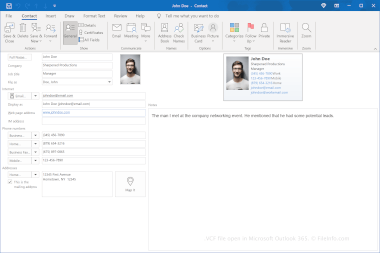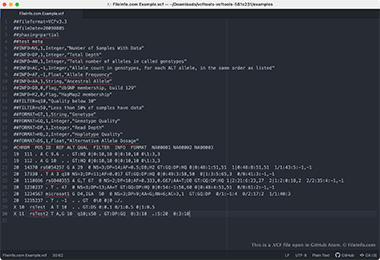.VCF File Extension
vCard File
| Developer | N/A |
| Popularity |
3.4 | 1309 Votes |
What is a VCF file?
A VCF file is a standard file format for storing contact information for one or more persons or a business. It typically includes a name, address, phone number, email address, and other contact information. VCF files also support custom fields, images, and other types of media.
More Information
The VCF format is widely used for exchanging contact information between applications and devices. For example, you may export a person's contact information as a VCF file, then import it into a contact-organizing program on your computer.
Since VCF files are relatively small in size, you can attach a file to an email message and send it to yourself or other contacts. They can then import the contact information in the VCF into their own contact-organizing software, often by simply double-clicking the file.
How to create a VCF file
You may create VCF files from scratch by creating a new contact and exporting it. For example, in Microsoft Outlook, you can create a contact, then select File → Save As to create a VCF file.
Or, you can convert other file formats to the VCF format. For example, you can save .XLS or .XLSX files as .CSV files with Microsoft Excel, then convert them to VCF files with a simple converter program, such as "CSV to vCard."
Example of the vCard format (version 3.0) in plain text
BEGIN:VCARD
VERSION:3.0
PRODID:-//Apple Inc.//macOS 11.5.2//EN
N:Doe;John;;;
FN:John Doe
ORG:Sharpened Productions;
EMAIL;type=INTERNET;type=HOME;type=pref:[email protected]
EMAIL;type=INTERNET;type=WORK:[email protected]
TEL;type=CELL;type=VOICE;type=pref:123-456-7890
ADR;type=HOME;type=pref:;;12345 First Avenue;Hometown;NY;12345;United States
ADR;type=WORK:;;67890 Second Avenue;Businesstown;NY;67890;United States
NOTE:The man I met at the company networking event. He mentioned that he had some potential leads.
item1.URL;type=pref:https://fileinfo.com/
item1.X-ABLabel:_$!<HomePage>!$_
BDAY:2000-01-01
END:VCARDHow to open a VCF file
You can open VCF files with various applications. Windows users can open vCards with Windows Contacts and Microsoft People (bundled with Windows) and Microsoft Outlook (an email client included with Microsoft Office). Mac users can open vCards with the Contacts application included with macOS or the third-party Flexibits Cardhop app. Android and iOS users can also load vCards directly into the Contacts apps bundled with their respective operating systems.
Since vCards are saved in a text format, you can also open them with a plain text editor. However, the files may also include a block of binary data, which is often used to store a photo. Also, the information in the file will not be displayed the same as if it was opened in a contacts program.
Programs that open VCF files
Variant Call Format File
| Developer | 1000 Genomes Project |
| Popularity |
2.9 | 106 Votes |
A VCF file may also be a text file used in bioinformatics to store information about variant genetic sequences. It contains metadata that describes the file's format, source, created on date, and reference genome, and it contains column-formatted genetic sequencing data. VCF files are used as part of large-scale genotyping and DNA sequencing projects, such as the 1000 Genomes Project.
More Information
To streamline the storage of variant genetic information, the 1000 Genomes Project created the Variant Call Format (VCF). This format allows bioinformaticians to catalog variants of a genome without recording those variants' genetic data in their entirety. Instead, bioinformaticians save one default reference copy of the genome in a .FASTA or another file, and then they describe the genome's variants in a VCF file. This allows bioinformaticians to quickly review and analyze genetic variants, without sifting through redundant data.
In its header, the VCF file describes its own file format, created on date, source, and other relevant metadata. The most important piece of metadata is the VCF file's ##reference, which describes where the VCF file's reference genome is stored.
In its body, the VCF file contains variant genetic sequencing data that is separated into eight mandatory columns, including:
- CHROM: The name of the sequence on which the variation is being called
- POS: The 1-based position of the variation on the given sequence
- ID: The identifier of the variation or . if the identifier is unknown
- REF: The reference base at the given position on the reference sequence
- ALT: This list of alternative alleles at this position
- QUAL: A quality score associated with the inference of the given alleles
- FILTER: A flag indicating which of a given set of filters the variation has passed
- INFO: An extensible list of key-value pairs describing the variation
Some VCF files may contain additional columns of data, including FORMAT and SAMPLE.
How to open a VCF file
Because VCF files are plain text files, you can open and examine them using any text editor, such as Microsoft Notepad (Windows), Apple TextEdit (Mac), or GitHub Atom (cross-platform).
However, VCF files are meant to be used as part of genotyping and DNA sequencing catalogs. Those working with these catalogs can use the open-source VCFtools library (cross-platform) to edit and manipulate VCF files.

